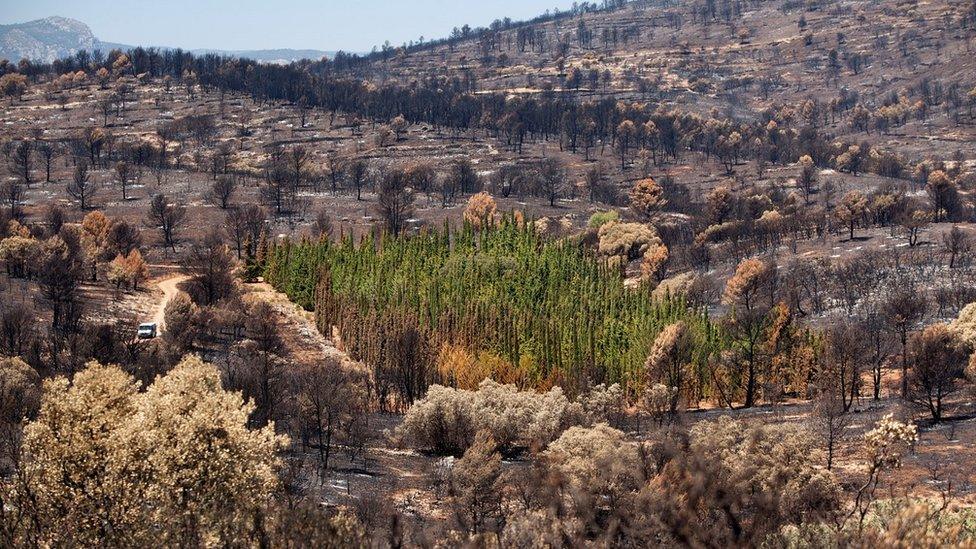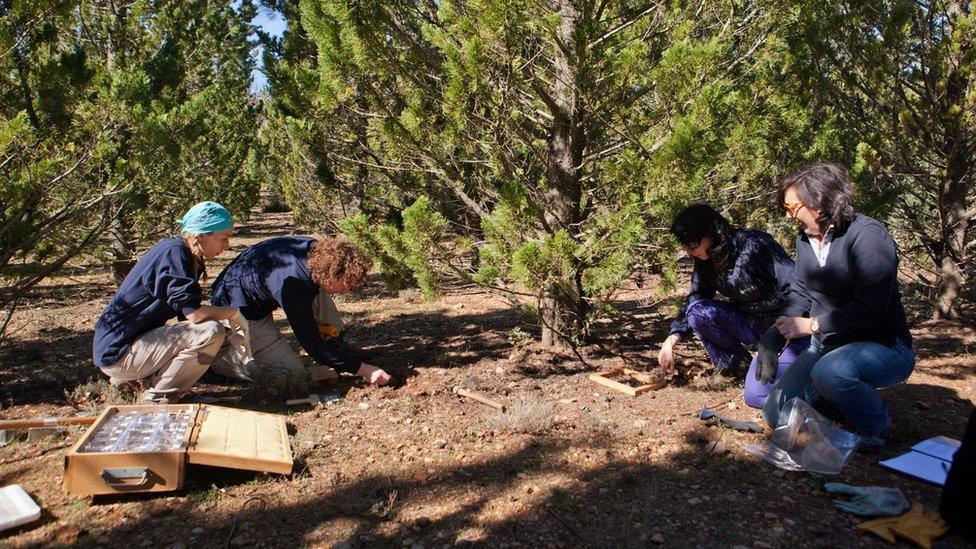Enigma of the trees that resist wildfires
- Published

Scientists are investigating whether the trees could provide a buffer zone to hinder the spread of wildfires
Spanish scientists Bernabé and José Moya couldn't believe their eyes.
More than 20,000 hectares of forest were charred. But in the middle of the devastation, a group of cypresses was still standing tall and green.
When a fire swept through an experimental plot in Andilla, in the Spanish province of Valencia in 2012, it gave researchers the perfect opportunity.
The plot, which was part of CypFire, a project financed by the European Union, was established during the 1980s to test the resistance of more than 50 varieties of Mediterranean cypress to a pathogenic fungus.
After the fire event of 2012, it also provided further anecdotal evidence of the peculiar resilience of the species in the face of fire.
Botanist Bernabé Moya and his brother, environmental engineer José Moya, both from the department of monumental trees in Valencia, had been involved in the project for several years.
"On our way to what we knew would be a Dante-esque scene during that tragic summer, we felt deep sadness at the thought of losing a plot of such value to the conservation of biodiversity," Bernabé Moya told BBC Mundo.
"But we had hope that perhaps some of the cypresses had survived."
"When we got there we saw that all the common oaks, holm oaks, pines and junipers had completely burnt. But only 1.27% of the Mediterranean cypresses had ignited."
Puzzling resilience
The fire in Valencia led to a three-year international study to find the reasons behind the resilience of the species and discover if it could provide buffer zones to hinder or prevent the rapid spread of wildfires.
Human-induced fires represent one of the most frequent causes of forest degradation in the Mediterranean region.
More than 269,000 fires were reported in the region between 2006 and 2010 with more than two million hectares of forest land burnt, according to the UN's Food and Agriculture Organization (FAO).
The study was published in this month's issue of the Journal of Environmental Management, external.

The forest litter beneath cypress trees is dense and acts as a "sponge", retaining water
The lab tests were performed by scientists from the Forest Fire Laboratory at INIA-CIFOR in Spain, and the Institute for Sustainable Plant Protection in Florence (IPSP), Italy.
"In the past, this species was not studied in depth or only a few parameters were measured," explained Gianni Della Rocca, research technologist at IPSP.
"Furthermore, using different techniques the results of flammability tests in vegetation can be different or even contradictory."
A crucial difference of the new tests is that they were performed not only on dead dry samples but also on live fine twigs with leaves taken from different crown heights, which revealed one of the key traits of the species: its high water content.
"We observed that the Mediterranean cypress, because of the particular structure of its leaves, is able to maintain a high water content even in situations of extreme heat and drought, and this is a very favourable starting point concerning fire risk," explains Mr Della Rocca.
"The cuticle is thick and the stomata are arranged on the inside and protected side of the scale-like leaves and therefore less subject to high water loss".
Moya says that "ignition time of live parts of the Mediterranean cypress is between one, five and seven times that of other Mediterranean species like Quercus ilex, Juniperus communis or Pinus pinaster under the experimental conditions of our tests".
The litter on the forest floor, made up of small fragments of leaves, also forms an intricate and compact layer and is slow to decompose.
"The thick and dense litter layer acts as a 'sponge' and retains water, and the space for air circulation is reduced", says Della Rocca.
The hollow crown
Scientists used selected genotypes of one variety of Mediterranean cypress, Cupressus sempervirens var. horizontalis, which is resistant to bark canker disease.
"This pandemic caused by the pathogenic fungus Seiridium cardinale is a very dangerous threat to the cypress. It causes the dieback of large portions of the crown and resin exudations from trunk and branches", explains Mr Della Rocca.
In contrast to other varieties that have dense crowns, the horizontalis branches insert themselves at angles between 45 and 90 degrees to the trunk. This means trees have a sparse canopy and dead foliage does not usually remain trapped.
According to Mr Della Rocca, "the crown structure of a tree is important because it determines the surface/volume ratio of potential fuel, the amount of circulating air and the moisture retention."
Plantations with selections of cypresses have already been made in Valencia, Spain, and Siena, Italy, to further research the role of crown structure.
"In a few years, we will have cypress barriers and observations at real scale," Mr Della Rocca says.

The Mediterranean cypress is able to maintain a high water content in extreme heat and drought
In highly resinous species, like pines, and during the heating phase, volatile organic compounds or VOCs, mainly terpenes derived from resins common in conifers, are crucial in priming or accelerating combustion.
The cypress is different.
"From preliminary tests we observed that, in our experimental conditions, in pines, the degassing of those flammable compounds happens quickly. The ignition starts soon from those gases and then it is transmitted to the twigs and needles," says Mr Della Rocca.
"In the case of the cypress, maybe the volatile very flammable compounds are degassed a bit at a time during the warming phase that precedes the ignition so they don't contribute to the combustion process."
Mr Della Rocca and his colleagues are now carrying out separate research to further understand the role of VOCs on flammability.
Other territories
Could the Mediterranean cypress help combat wildfires in other parts of the world, like California or the Patagonia in Chile and Argentina?
According to Bernabé Moya, the species has a "great plasticity in terms of soil, climate and altitude. It can grow on all soils, even degraded ones, apart from those that are water-logged, and it thrives from sea level to altitudes of more than 2,000 metres".
The species has been introduced in Latin America, says Mr Moya, and could grow without problems in the temperate climate of California, Chile or Argentina.
"The first thing would be to study the adaptability of different varieties of Mediterranean cypress to local conditions and establish experimental plots," he explains.
One of the main conclusions of the European study, according to Mr Rocca, is that peculiar plantations with selected varieties of cypress seem a possible alternative new tool to counteract the risk of wildfires in some sensitive sites like wild-urban-interfaces or wild-industrial-interfaces.
"Our study has led to the introduction of Cupressus sempervirens var. horizontalis into a special list of tree species eligible for interventions against forest fires in a Regional Law of Tuscany," he explains.
In Valencia, Bernabé Moya and his colleagues will plant the first barriers of the Cypress system in the autumn, using specially selected varieties of Mediterranean cypress.
For Mr Moya, "the vulnerability of vegetation to fires is linked to the lack of information available to the public, the lack of support for research and the lack of plans for the sustainable management of forests - a situation that will get worse with climate change".
For the Spanish scientist, many problems like desertification, wildfires, soil degradation and loss of biodiversity could be reverted if there was more tree planting and if people took more care of forests in the first place.
"It is urgent that humanity takes these problems seriously," he told the BBC.
"The fight against fires concerns us all. We owe it to the forests and we owe it to future generations".